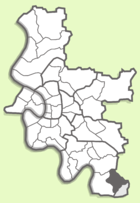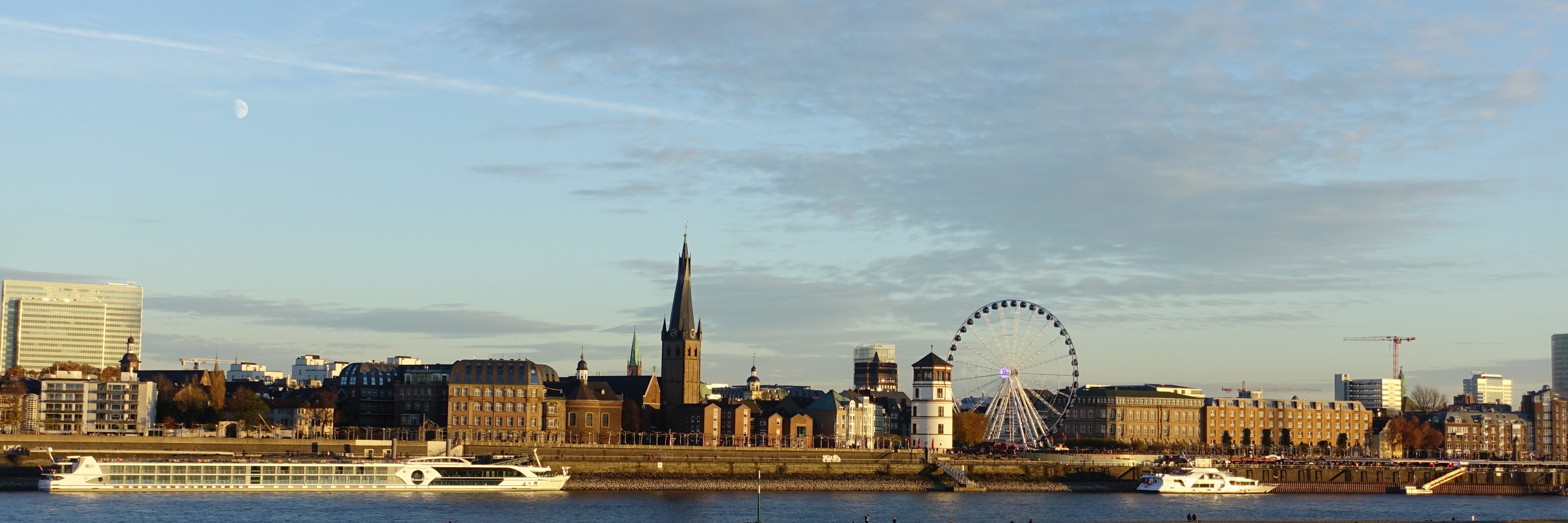A while ago, I needed to get a document from one of the “citizens’ offices” (Bürgerbüros) in Düsseldorf. There are about ten of them. You request an appointment online, and get pointed to whichever office can give you an appointment the soonest. This time, it was in the neighborhood of Garath.
Yes, Garath. At the mention of these two syllables, Düsseldorfers will hear ominous string music — or perhaps a song from a band with a name like Nahkampf or Erschießungskommando.
Garath is a neighborhood at the very southern tip of Düsseldorf, a 13-minute S-Bahn ride from the center. It’s the dark-gray bit in this map of Düsseldorf. Its basic design was laid out in 1959 by the notorious (and notoriously auto-friendly) Düsseldorf architect and city planner Friedrich Tamms (think of him as the Robert Moses of Düsseldorf) as a planned community of medium-rise apartment buildings, 8000 apartments capable of housing 30,000 people. Because it was largely a designed community, critics call it a Retortensiedlung — a test-tube town, as opposed to a neighborhood which grew up organically. Tamms’ plan, with many modifications and additions, was realized in stages during the 1960s and 1970s. The overall style was mild Brutalism, described (g) as an “explicitly solid and respectable style which affords no room for architectural experiments or reforms.” In other words, cheap buildings for workers.
1959 by the notorious (and notoriously auto-friendly) Düsseldorf architect and city planner Friedrich Tamms (think of him as the Robert Moses of Düsseldorf) as a planned community of medium-rise apartment buildings, 8000 apartments capable of housing 30,000 people. Because it was largely a designed community, critics call it a Retortensiedlung — a test-tube town, as opposed to a neighborhood which grew up organically. Tamms’ plan, with many modifications and additions, was realized in stages during the 1960s and 1970s. The overall style was mild Brutalism, described (g) as an “explicitly solid and respectable style which affords no room for architectural experiments or reforms.” In other words, cheap buildings for workers.
Today, Garath is a solidly working-class section of Düsseldorf. It’s mostly white, with a percentage of foreigners of only 12.5% (g), well under the city’s average of 19.2%. There seemed to be a strong Eastern European and Russian presence — they wouldn’t affect the foreigner percentage, since many of them would be Russians or East Europeans of German descent (g), who are entitled to German citizenship.
Garath has a reputation as one of the social burning points of Düsseldorf, a cluster of sterile pre-planned buildings stuffed with the resentfully unemployed. There are stories of rabid football fans, right-wing violence, mass fistfights, urine-soaked undergrounnd passages, the whole nine yards. But people from Garath tend to be loyal to it. It ain’t fancy, but it’s nowhere near as dangerous or desolate as its reputation. People know each other and help each other, and there’s plenty of green space and even a small castle (g).
Garath city center is like a small throwback to the idea of a socialism-infused, egalitarian model of German society. There are large paved squares with benches where local day-drinkers can soak up the sun:

There are also funky small modular orange shops under the train overpass, looking as if they were plucked straight from 1974. One of them houses the “Altschlesische Speisekammer” (The Old Silesian Pantry), a which sells Polish food, including delectable sausage:
There’s a bunch of government offices right next to the main train station, and right next door, a “Leisure Center”, made of modest red brick, where people can go spend time for free, or at least a modest fee. This building was designed by Olaf Jacobson in 1974. It’s made of interlocking cubes of different sizes stacked on top of and next to one another, faced in handsome red-brick. Inside, pathways lead from one modular cube to the next, creating interesting, inviting spaces.
When I stopped by the auditorium, there was a group of at least 80 old ladies settling into their seats for some sort of concert. The local library branch is located inside the building, and offers this inviting reading nook:

On the side of the leisure center is a quote from Heine about Old Düsseldorf’s funky nooks and crannies:

Of course, there’s an ice-cream parlor:

And a little bit of urban decay:

But also delectable fruits right across from it:

And a bar next to the train station with this oddly charming…whatever it is:

And is there public art? Yes, the “Sunwheel” by Friedrich Becker, erected in 1976 (obviously):

Behind it you can see the housing blocks typical of Garath. They’re nothing special, but at least they’re not Corbusian nightmares. Facing the train tracks, there’s “Countdown”, by Hans-Albert Walther:

There’s too much concrete in the heart of Garath, a common problem with 1960s and 1970s town planning. But still, there are some interesting buildings, and a bit of funky pre-planned quasi-socialist charm. Infinitely worse things have come out of test tubes.













 1959 by the notorious (and notoriously auto-friendly) Düsseldorf architect and city planner Friedrich Tamms (think of him as the Robert Moses of Düsseldorf) as a planned community of medium-rise apartment buildings, 8000 apartments capable of housing 30,000 people. Because it was largely a designed community, critics call it a Retortensiedlung — a test-tube town, as opposed to a neighborhood which grew up organically. Tamms’ plan, with many modifications and additions, was realized in stages during the 1960s and 1970s. The overall style was mild Brutalism,
1959 by the notorious (and notoriously auto-friendly) Düsseldorf architect and city planner Friedrich Tamms (think of him as the Robert Moses of Düsseldorf) as a planned community of medium-rise apartment buildings, 8000 apartments capable of housing 30,000 people. Because it was largely a designed community, critics call it a Retortensiedlung — a test-tube town, as opposed to a neighborhood which grew up organically. Tamms’ plan, with many modifications and additions, was realized in stages during the 1960s and 1970s. The overall style was mild Brutalism, 











































